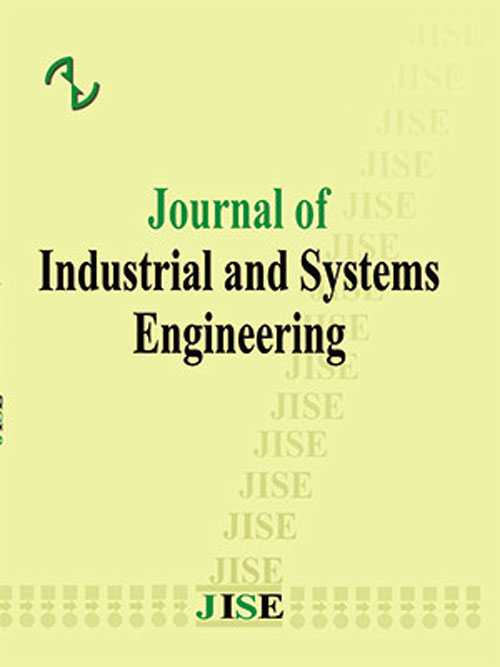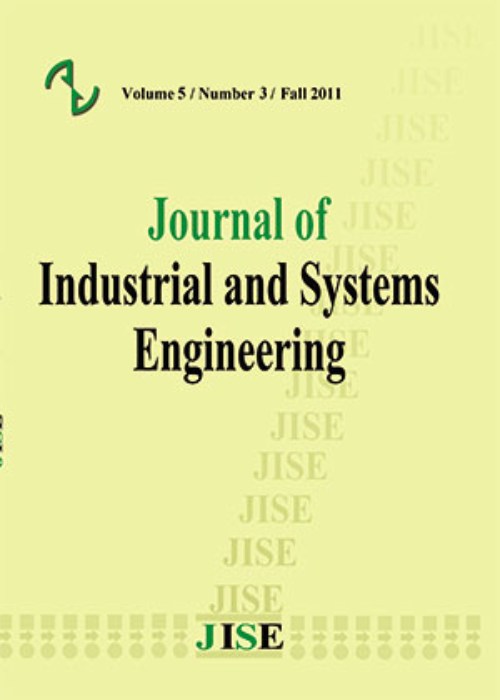فهرست مطالب

Journal of Industrial and Systems Engineering
Volume:9 Issue: 1, Winter 2016
- تاریخ انتشار: 1394/12/01
- تعداد عناوین: 7
-
-
Pages 1-16In this research, we propose a bi-objective model for the economic-statistical design of the X-bar and S control charts. The model minimizes out-of-control average time to signal as well as minimizing mean hourly loss-cost where it incorporates the Taguchi loss function. Statistical constraint is considered in the model to achieve desired in-control time to signal. A non-dominated sorting genetic algorithm is developed to obtain the Pareto optimal scheme of the control chart. Sensitivity analysis and comparison study with traditional economic models proves that the proposed bi-objective design of X-bar and S control chart ensures a better approach to improve the quality system and increase the plans ease of use.Keywords: Control Chart, Economic, Statistical Design, Average Time to Signal, Taguchi loss function, Bi, objective Optimization
-
Pages 17-34Decision making plays an important role in economics, psychology, philosophy, mathematics, statistics and many other fields. In each field, decision making consists of identifying the values, uncertainties and other issues that define the decision. In any field, the nature of the decisions is affected by environmental characteristics. In this paper, we are considered the production planning problem in a stochastic and complex environment, i.e. the environment of electronic equipment production, where planning is done with variable results and changeable requests. In this complicated environment we are encountered with joint replenishment, variable yields and exchanging demands and many other complex variables related to inventory management and control systems that have complicated and unpredictable behavior and could not be simply modelled. We are trying to modelling this environment as a stochastic problem. The aim of mathematical model is managing and controlling inventories in such a complex production environment. We also try to solve this proposed stochastic problem by estimation procedures. The planning problem is devised as a gain-maximizing stochastic program. Also we use Arena and Matlab softwares to predict the behavior of production system in various situations. The results of these simulations are mentioned in the paper.Keywords: Manufacturing, Decision Making, Inventory policies, Stochastic yield
-
Pages 35-56The importance of supply chains in pharmacological industry is remarkable so that nowadays many pharmacological supply chains have an effective and critical role for supplying and distributing drugs in health area. So, this study studies a three-echelon pharmacological supply chain contained multi-distributor of raw materials, a pharmaceutical factory, and multi-drug distributors companies such that distributors of raw material, order raw materials of some drugs to own suppliers and sell them to the pharmaceutical factory. Then it transmutes raw materials to the several finished products and sells them to the some drug distributors companies. There are several types of raw materials and finished products.
Here, it is supposed that the market powers of partners are different. So, the Stackelberg game among the members of the chain is deemed to analyze the coordination behavior of the members of the proposed chain. The aim of the research is to maximize the total profit of supply chain by employing the optimal pricing and ordering decision policies where the order quantities of the distributors and the selling prices of pharmaceutical factory (manufacturer) and the distributors are the decision variables. Besides, the closed form solutions of the decision variables are presented. At the end, numerical example and some sensitivity analysis are presented.Keywords: Pricing, Inventory, Production, Health Care, Game theory, Supply Chain -
Pages 57-78The Taguchi method is a useful technique to improve the performance of products or processes at a lower cost and in less time. This procedure can be categorized in the static and dynamic quality characteristics. The optimization of multiple responses has received increasing attention over the last few years in many manufacturing organizations.
Several approaches dealing with multiple static quality characteristic problems have been reported in the literature. However, little attention has been made on optimizing the multiple dynamic quality characteristics.
In this paper, we investigate multivariate signal response systems (Dynamic Taguchi) and propose a method based on multivariate process capability. Simulated data shows that the proposed method can increase robustness of dynamic Taguchi method. Furthermore, proposed method is capable to find the optimal value of controllable factors in a continuous space.Keywords: Signal response system, Robust parameter design (RPD), Dynamic Taguchi design, Process capability index -
Pages 79-91In this paper, an analytical approach is used for assembly line rebalancing and worker assignment for single and mixed-model assembly lines based on a heuristic-simulation algorithm. This approach helps to managers to select a better marketing strategy when different combinations of demands are suitable.Furthermore, they can use it as a guideline to know which worker assignment is better for each combination. We show the efficiency of the proposed approach for single and mixed-model assembly lines using different benchmarked standard test problems with different number of tasks, stations, skilled workers and demands. Comparisons show the heuristic-simulation algorithm is faster than the GAMS software, and its results are optimum or very close to the optimum values.Keywords: Assembly line rebalancing, problem, worker assignment, heuristic, simulation algorithm, task time dependent on the worker's skill
-
Pages 92-108This paper considers the reliable multi-product multi-vehicle multi-type link logistics network design problem (RMLNDP) with system disruptions, which is concerned with facilities locating, transshipment links constructing, and also allocating them to the customers in order to satisfy their demand on minimum expected total cost (including locating costs, link constructing costs, and also expected transshipment costs in normal and disruption conditions). The motivating application of this class of problem is in multi-product, multi-vehicle, and multi-type link logistics network design regarding to system disruptions simultaneously. In fact, the decision makers in this area are not only concerned with the facility locating costs, link constructing costs, and logistical costs of the system but also by focusing on the several system disruptions states in order to be able to provide a reliable sustainable multi configuration logistic network system. All of the facility location plan, link construction plan and also link transshipment plan of the demands in the problem must be efficiently determined while considering the several system disruptions. The problem was modeled as a MIP. Also, a hybrid heuristic, based on LP relaxation approach, is proposed. Computational experiments illustrate that the provided algorithm will able to substantially outperform the proposed integer programming model in terms of both finding and verifying the efficient optimal (or near optimal) solution at a reasonable processing time.Keywords: Multi, product, Multi, type transshipment links, Multi, vehicles, Logistic network design, Disruptions, Reliability, Two stage decomposing heuristic, LP relaxation, Heuristic algorithm
-
Pages 109-125This paper presents a multi-objective optimization model for the design of a waste management system consisting of customers, transfer stations, landfills and collection vehicles. The developed model aims to simultaneously minimize the total costs, greenhouse gas emissions and the rates of energy consumption. To tackle the multiple objectives in the problem, we utilize an interactive fuzzy programming solution approach. The model is capable of determining the location and allocation of transfer stations as well as the selection of the waste processing technologies. The application of the proposed model is examined in a case problem where real data is used for long-term planning of solid waste of Tehran.Keywords: Waste management systems, Facility location, Transfer stations, Multi, objective optimization


